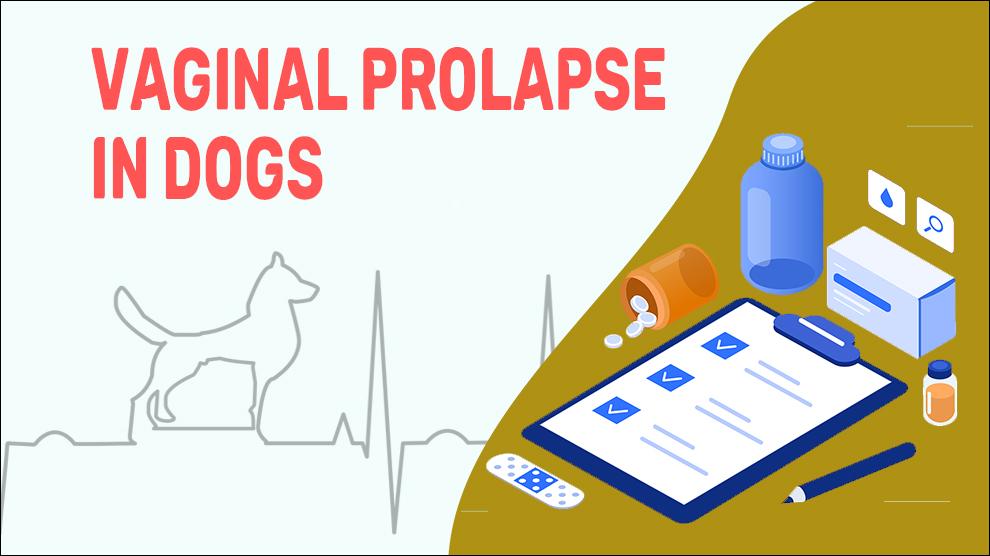What Is Vaginal Prolapse In Dogs?
Vaginal prolapse is the swollen (edematous) vaginal tissue of internal vaginal walls protruding through the vulva opening, which is the external portion of a female genital organ, occurring during pro-oestrus and estrus phase of the heat (estrus) cycle. The complete limits of the wall of vagina protrude, giving the prolapsed pink, fleshy mass a donut-shaped look.
Vaginal prolapse is most prevalent in young, larger breed female dogs that are not spayed. For affected dogs, it's often more in the “you can't miss it” zone as the pet would be paying so much attention to that area. Generally the prolapse begins soft and shiny protrusion but in due course gets dried up, after that there will be development of cracks called fissures. This is mainly caused by an overreaction to increased oestrogen levels and tends to occur when the dog is in heat (estrus) and/or goes into heat (proestrus).
Other causes of vaginal prolapse are persistent urinary tract infections; a stoppage during coitus before mating can occur and lengthened straining due to a complicated labor and delivery. Vaginal prolapse makes it difficult for dogs to urinate. Although the prognosis for recovery is positive for most dogs, the possibility of the prolapse recurring all through pregnancy, or at delivery is quite possible. Spaying the animal may be recommended as breeding may place the dog at further risk for the condition.
Symptoms Of Vaginal Prolapse In Dogs
- Protrusion of round, red or pink inflamed tissue from the vulva
- Resistance to mating, even during heat cycle
- Excessive licking of the vulvar area
- Painful or difficult urination
Treatment Options For Vaginal Prolapse In Dogs
- Hormonal therapy: This is to induce ovulation
- Surgery: Vets perform surgery or Resection to take away vaginal mucosal tissue that are necrotic or dying
- When there is only minimal tissue damage, prolapsed tissues are first cleaned properly; applying hypertonic dextrose or sugar to reduce swelling and then vets will push it back in by hand. The place will then be sutured
- Additional fluids and an IV catheter also may be required during the surgery.
- Antibiotics, antifungals, Antivirals or anthelmintics medications
- Pain medication: NSAIDs (Carprofen, Meloxicam, Firocoxib, Galliprant)
Home Remedies For Vaginal Prolapse In Dogs
- Gently apply water-based lubricating jelly or petroleum jelly or saline with a clean cloth to stop the prolapsed tissue from drying out.
- While vaginal prolapsed is not a medical emergency, it is better to visit the vet as soon as possible.
How To Prevent Vaginal Prolapse In Dogs?
- There is no real way to prevent a vaginal prolapse. Some of the breeds inherit the condition and others acquire it through other health issues.
- Consult with breeders/vet to find out if the breed has a history of a vaginal prolpase.
- Spayed female dogs are safe from vaginal prolapse.
Affected Dog Breeds Of Vaginal Prolapse
Airedale Terrier, American Pit Bull Terrier, Boxer, Chesapeake Bay Retriever, English Springer Spaniel, English Bulldog, German Shepherd, Labrador Retriever, Mastiff, Saint Bernard, Weimaraner, Female Dogs
Causes And Types For Vaginal Prolapse In Dogs
1. Cause:
- Genetics
- Vaginal hypoplasia
- Estrogen stimulation
- Persistent Urinary Tract Infection
2.Types:
- Type 1- Small protrusion, although it does not exit the vulva itself
- Type 2 – Most of the vaginal tissue protrudes through the vulvar opening
- Type 3 – Significant protrusion as the donut-shaped tissue mass can be seen externally
3. Mortality:
There is no documented mortality connected with vaginal prolapse. Older dogs are at greater risk of getting incapacitated than younger dogs.
4. Diagnosis:
- A complete blood count (CBC), chemistry profile
- Physical exam
- Abdominal ultrasound
5. Prognosis:
Type 1 prolapse of vaginal tissue may resolve on its own after the underlying cause for straining gets over or cured. Type 2 or 3 prolapse of vaginal tissue or prolpase that blocks the urethra will be cleared only by medical and/or surgical intervention.
When To See A Vet For Vaginal Prolapse In Dogs?
Contact your vet right away, if you notice:
- Protrusion of round, red or pink inflamed tissue from the vulva
- Resistance to mating, even during heat cycle
- Excessive licking of the vulvar area
- Painful or difficult urination
Food Suggestions For Vaginal Prolapse In Dogs
- Moderate-protein - low-sodium diet, high-alkaline foods
- Green Leafy Vegetables, Almonds, Avocado, Cucumber, Beets, Figs and Apricots
- Herring, Sardines, Mackerel, Trout, salmon, etc
- Legumes such as lentils, chickpeas, kidney beans
- Plant-based protein sources – Chickpeas, Lentils, Nuts, Seeds and potatoes
- Fresh fruit/ vegetables: Banana, apple, citrus fruits, water melon, green beans, carrots, etc
Conclusion
Vaginal prolpase in dogs is highly embarrassing for owners and they should consider the diagnosis with the proper clinical signs. Despite proper treatment, three out of four affected dogs have a relapse at the time of the next estrus. Spay (Ovariohysterectomy) prevents recurrence and may speed up healing.

















